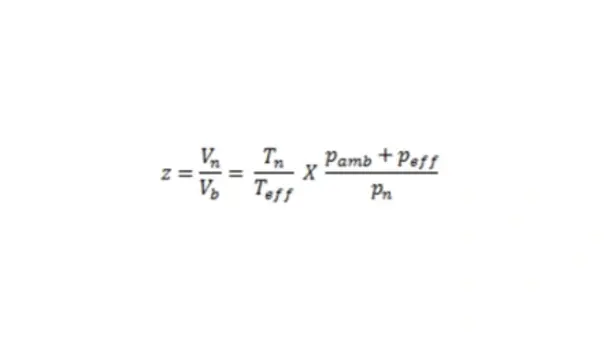Natural gas billing according to G685
From now on, you will find two new factors on your natural gas bill that are used to calculate the natural gas supplied: the condition number and the billing calorific value. They replace the previously used conversion factor.
The starting point for billing is the quantity of gas consumed between two points in time. The gas meter for natural gas, the diaphragm gas meter in the domestic and small commercial sector, measures the quantity, i.e. the operating volume (Vb) in m³ of the natural gas flowing through the gas meter. For you as a gas customer, however, it is not so much the volume of natural gas consumed that is of interest, but rather the amount of thermal energy it contains. This requires a conversion from the measured operating volume Vb (m³) to the purchased thermal energy quantity (E) in kWh.
The billed amount of energy is calculated from three values: the natural gas consumption, the condition number and the billing calorific value.
Worth knowing
Natural gas consumption is measured using a calibrated gas meter. This measures the operating volume (Vb) of the natural gas flowing through it. The unit of measurement is cubic metres (m³). The natural gas consumption is calculated from the difference between the meter reading at the beginning and end of a billing period (usually 12 months).
In the case of natural gas, a distinction is made between the standard state and the operating state. The operating state is the state of the natural gas in the gas meter, which depends on the pressure and temperature of the natural gas. The operating state of the natural gas must therefore be converted to the standard state in order to bill the quantities of natural gas consumed. Natural gas has its standard state at a standard temperature (Tn) of 0 °C and a standard pressure (pn) of 1013.25 mbar.
The condition number (z) describes the ratio of the billing-relevant standard volume (Vn) to the measured operating volume (Vb) of the natural gas. The condition number is determined on a customer-specific basis. In principle, a billing temperature (Teff) of 15 °C has been defined for gas meters without temperature conversion throughout Germany, provided that the transferred pressure (transfer pressure) at the customer is less than or equal to 1,000 mbar and does not exceed an hourly volume of less than 400 m³/h. The mean air pressure (pamb) to be used, measured in mbar, is determined by the geodetic height of the meter installed at the customer's premises. Mittelhessen Netz GmbH (MIT.N) has established the altitude zone depending on the geographical conditions within its network area. All installed gas meters are assigned to an average geodetic height of the altitude zone. Another parameter for determining the condition number is the set overpressure, also known as effective pressure (peff), of the installed gas pressure regulator upstream of the customer's gas meter. The installed gas pressure regulator provides the gas meter with a constant outlet pressure in mbar. The consumption devices such as condensing boilers and gas hobs at the customer's premises are adjusted to this outlet pressure. Changing the effective pressure requires technical modifications to the gas pressure regulator, which may only be carried out by MIT.N.

where
z = condition number
Vn = standard volume [m³]
Vb = operating volume [m³]
Tn = standard temperature = 0 °C = 273.15 K
pn = standard pressure = 1,013.25 mbar
Teff = Temperature of the natural gas = 288.15 K (15 °C)
pamb = Air pressure at the gas meter [mbar] = 1,016 - (0.12 x H/m) [mbar]
H = assigned mean geodetic height of the gas meter [m]
peff = Overpressure at the gas meter [mbar]
As natural gas is a natural product, it is subject to slight fluctuations in composition and therefore also in energy content (calorific value) depending on the source of production. The calorific value of the natural gas supplied is determined using calibrated calorific value meters at the respective transfer point into the natural gas distribution network. The gas quality is therefore independent of the customer's chosen natural gas supplier. The calorific value of natural gas can vary between 8.4 kWh/m³ and 13.1 kWh/m³ according to DVGW worksheet G 260 "Gas quality". DVGW stands for Deutsche Vereinigung des Gas- und Wasserfaches e. V. (German Technical and Scientific Association for Gas and Water). In the network area of Mittelhessen Netz GmbH, Stadtwerke Gießen transports natural gas of group L with a calorific value of approx. 9.5 to 10.5 kWh/m³. The calorific value Hs is the amount of heat that would be released if a given quantity of gas were completely combusted in air, whereby the pressure p at which the reaction takes place remains constant and all combustion products are returned to the same given temperature T as the reaction partners. The calorific value for the respective billing period is determined on a current and customer-specific basis. Due to the natural fluctuations in the quality of natural gas and the time-related determination of the billing calorific value, there is no standardised calorific value for all customers. The billing calorific value is determined over the period of two meter readings (initial and final meter reading).
To calculate the amount of thermal energy (E) actually drawn, the operating volume (Vb) read from the gas meter is multiplied by the condition number (z) and the billing calorific value (Hs, eff): E = Vb x z x Hs, eff
Where mean:
E = Thermal energy [kWh]
Vb = Operating volume [m³]
z = condition number
Hs, eff = Billing calorific value [kWh/m³]
If the billing period has to be subdivided in the bill, e.g. due to changes in charges or taxes, and no reading of the gas meter is available, Stadtwerke Gießen AG determines the thermal energy quantity in accordance with the specifications of DVGW Code of Practice G 685.
Legal framework
In Germany, thermal natural gas billing is carried out on the basis of standardised calibration regulations and in accordance with the recognised rules of technology, in particular DVGW worksheet G 685 "Gas billing". The procedures laid down in this worksheet have been agreed with the state authorities for calibration and the Physikalisch-Technische Bundesanstalt and comply with the provisions of calibration law. Thermal natural gas billing is subject to constant monitoring by the responsible verification offices of the respective federal state. This also ensures maximum precision and independence.

